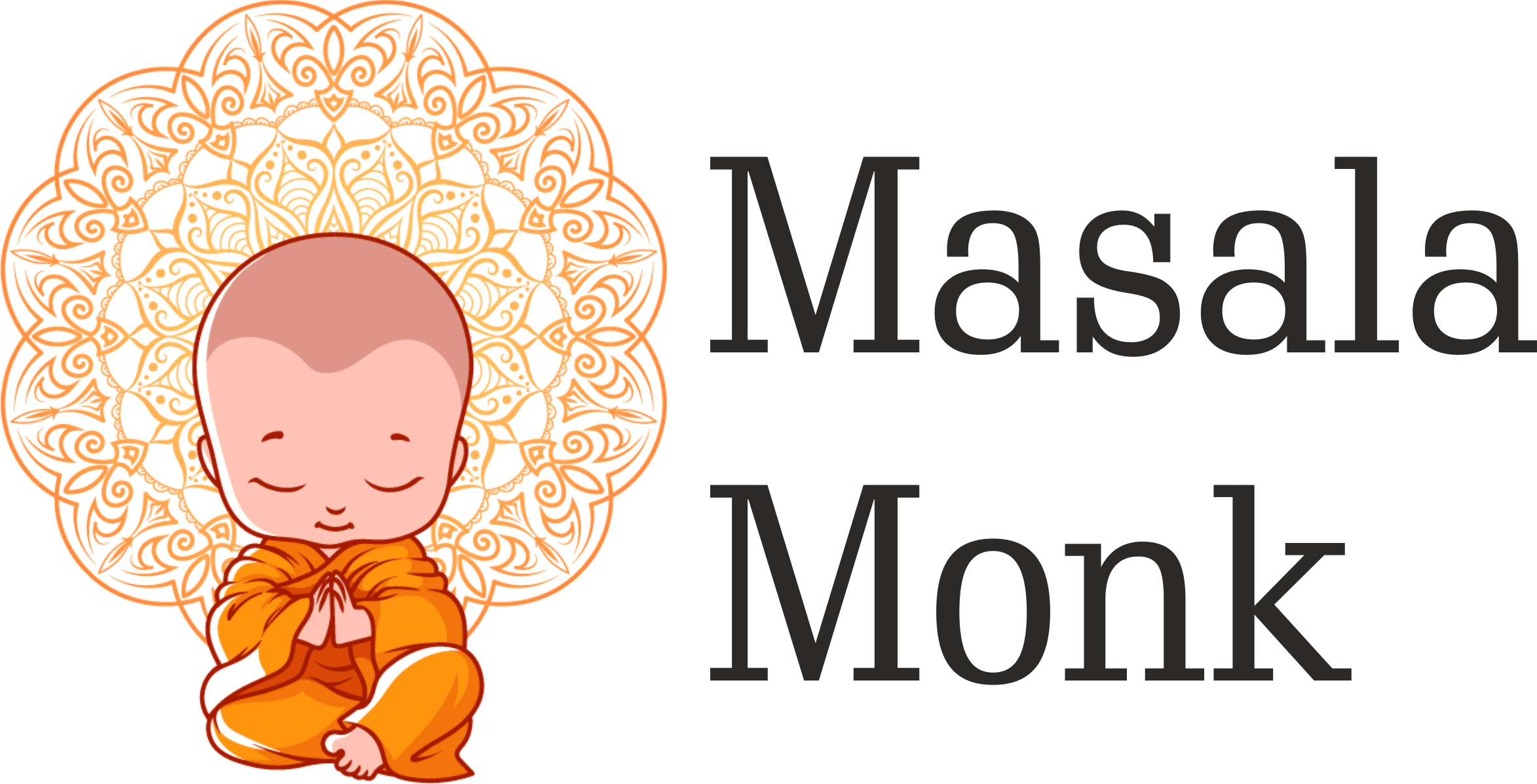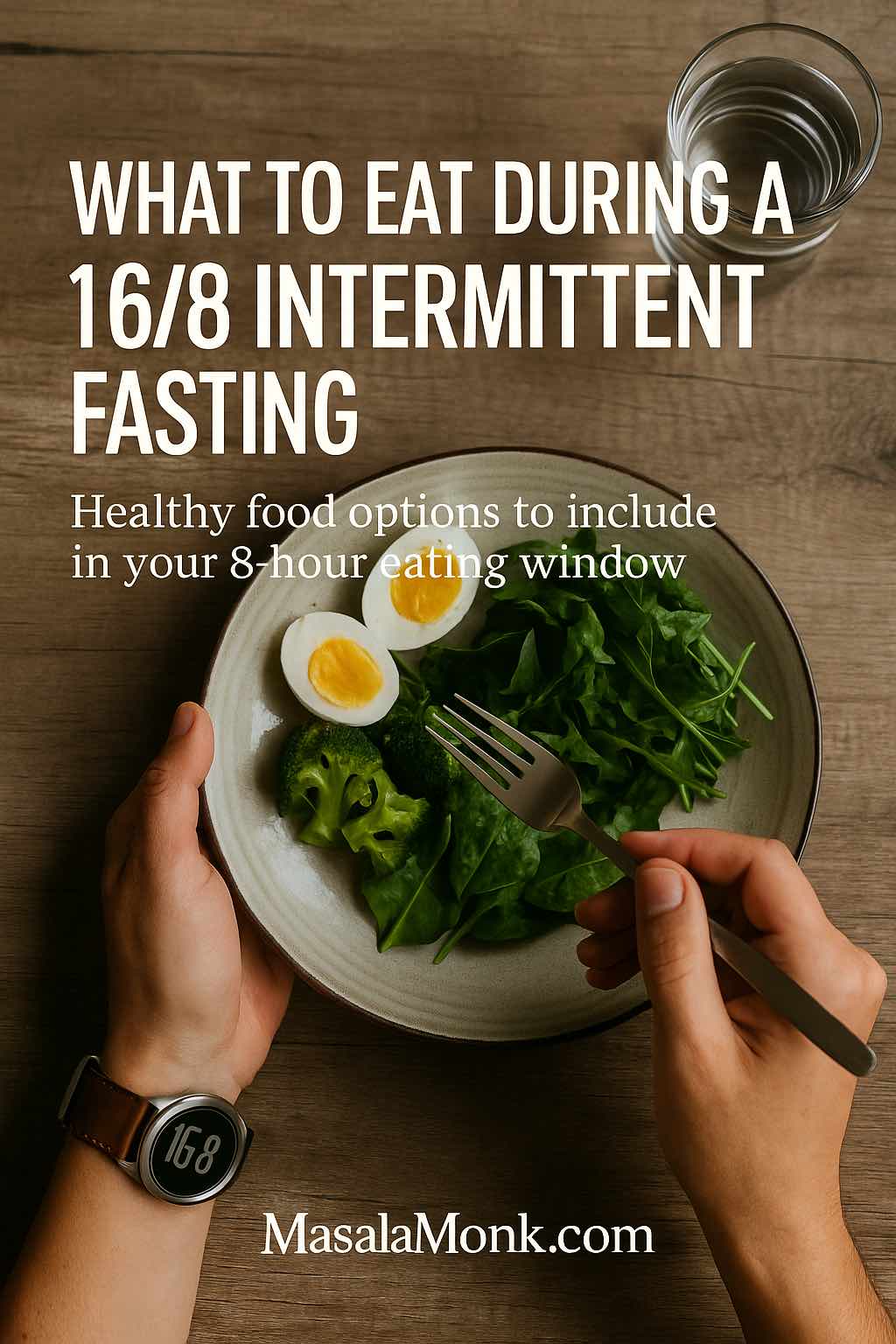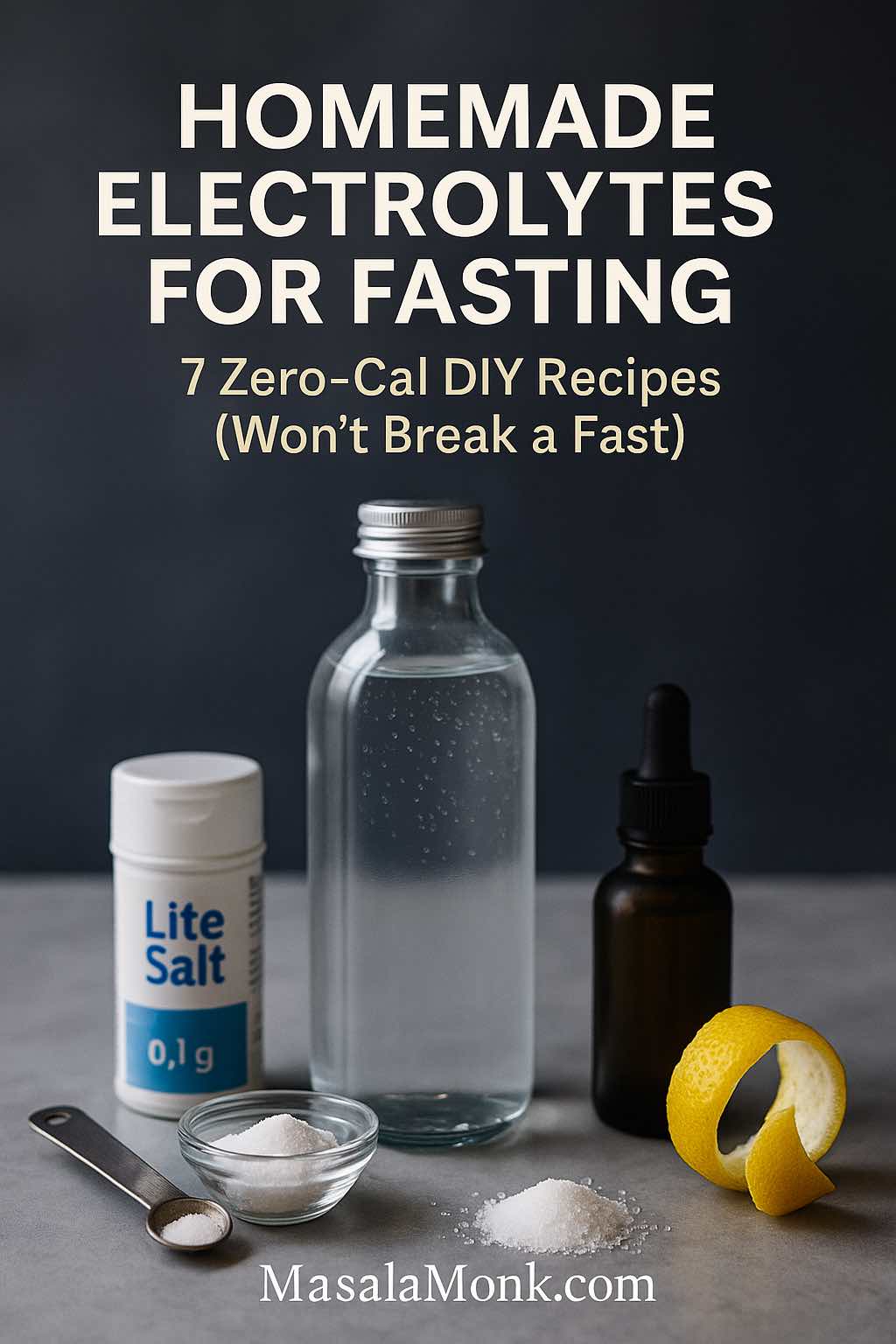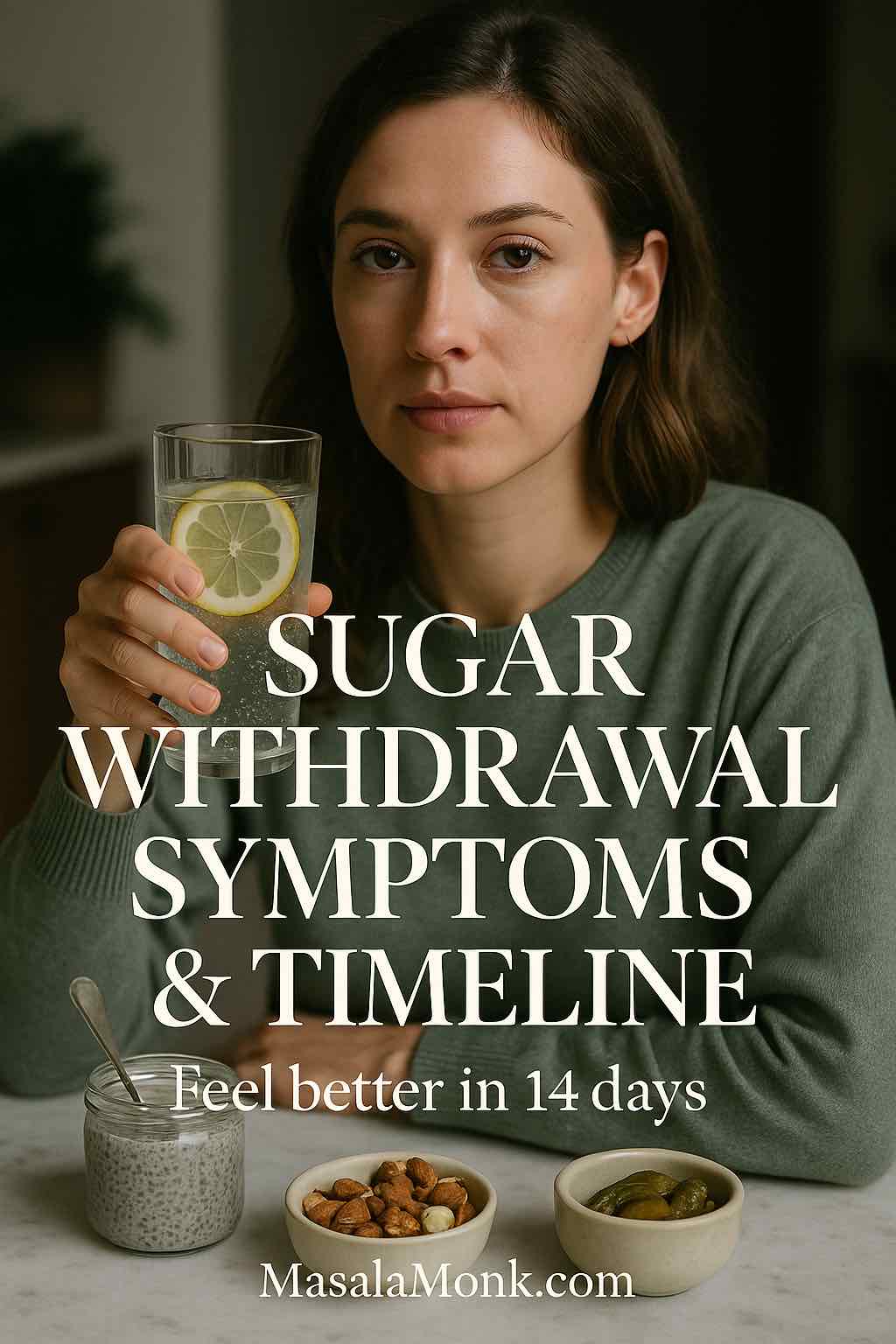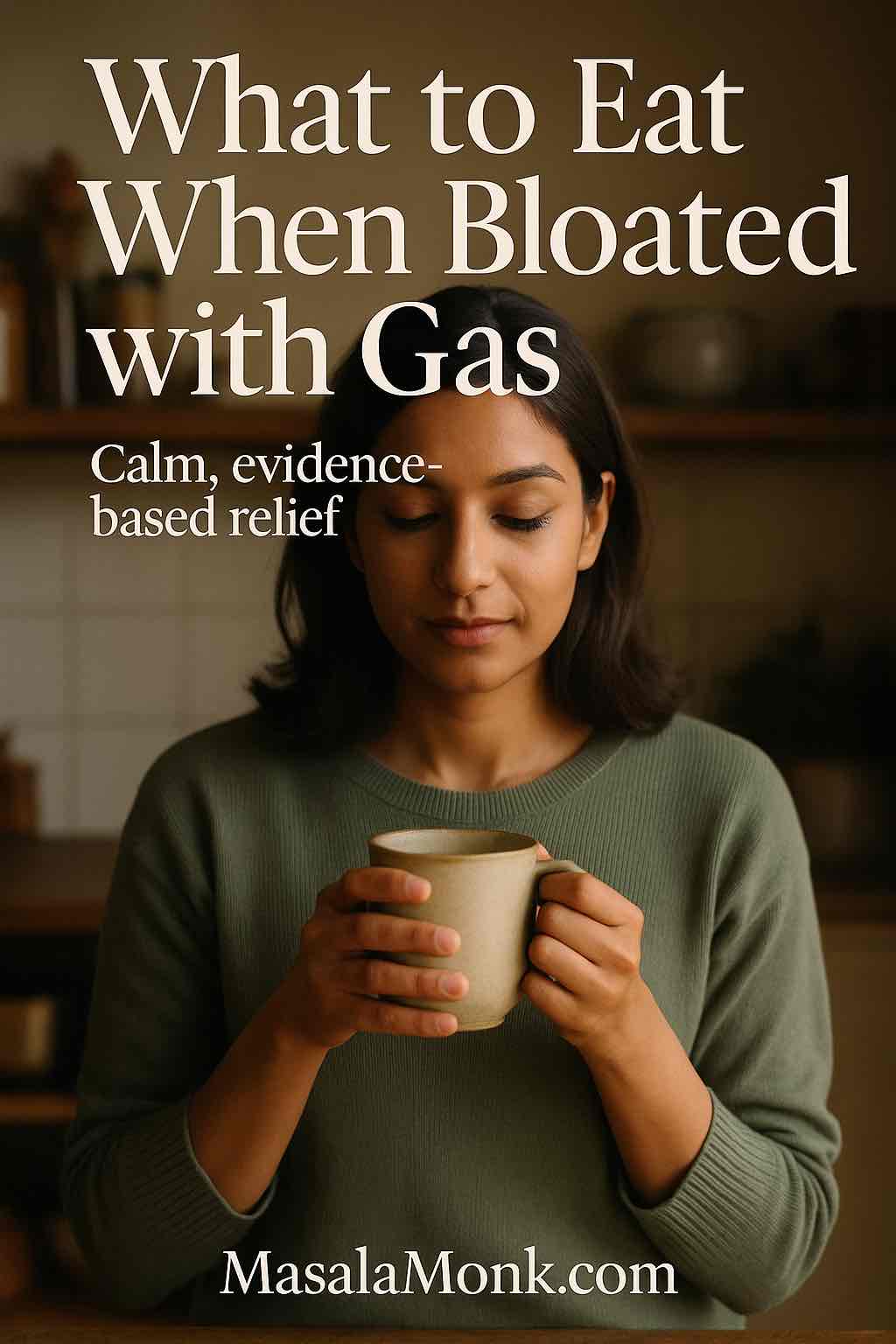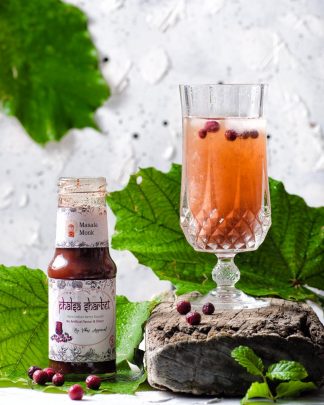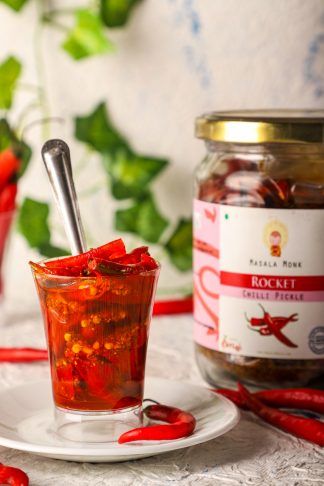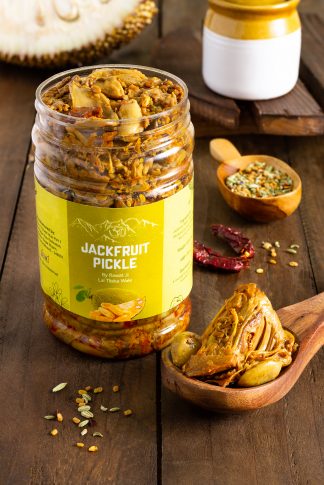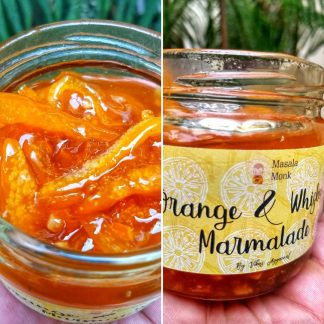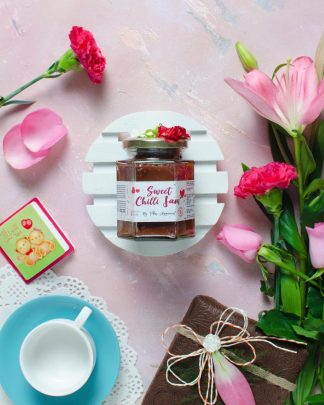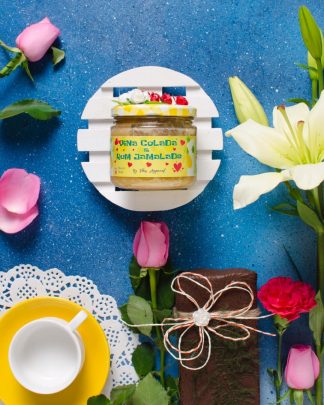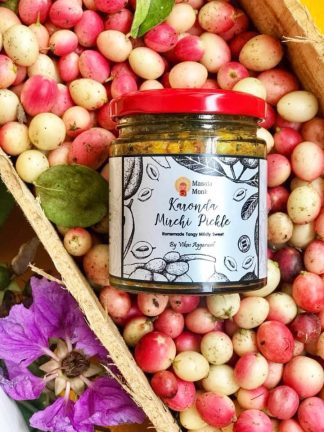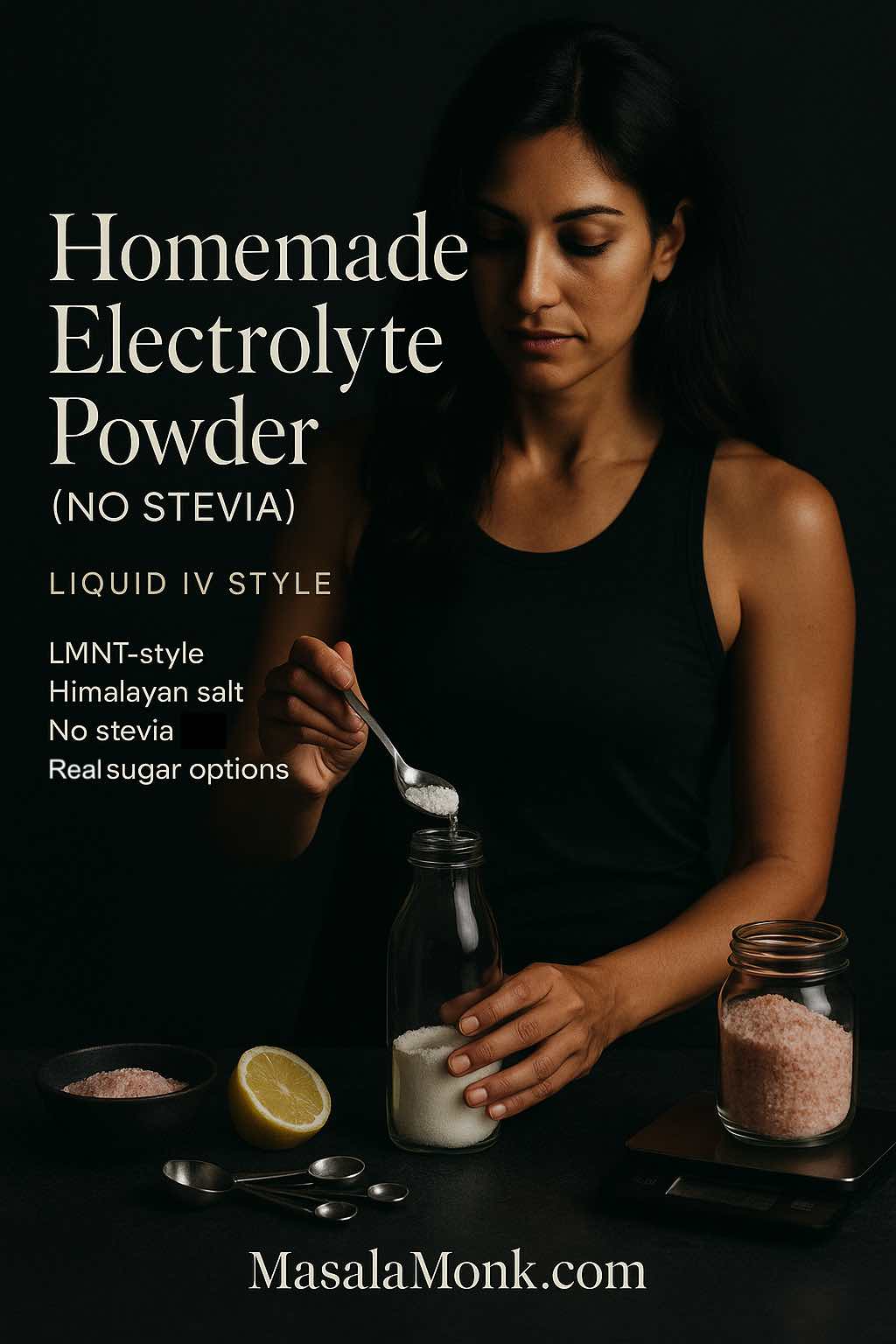
If store-bought hydration sticks feel expensive, too sweet, or cluttered with ingredients you’d rather skip, this homemade electrolyte powder gives you the same salty–citrus snap as the popular packets—minus stevia if you prefer. Beyond the cost savings, you’ll know exactly what’s in the bottle: salt for sodium, potassium salt for the complementary lift, a touch of magnesium for muscle and nerve function, and a clean citrus note to keep every sip bright. On slower training weeks or low-carb phases, you might also enjoy rotating in our Keto electrolyte drink ideas for additional variety without sugar.
Before we dive into recipes, a quick frame helps. For everyday living, plain water usually covers the bases. However, as sessions stretch past the hour mark—or heat and humidity spike—electrolytes can make the difference between merely getting through a workout and actually feeling steady. A practical rule of thumb many athletes use is to drink to thirst while keeping an eye on salt: the moment your bottle tastes oddly flat, you may be under-salting for the day; when it tastes harsh or briny, you may be overshooting. In either case, small tweaks add up.
Because people gravitate toward two distinct taste profiles, you’ll find both here. First, a pantry jar of homemade electrolyte powder (no stevia) you can scoop into any bottle in seconds—shelf-stable and simple. Second, two single-bottle mixes you can shake on the spot: a Liquid IV-style bottle with a little sugar and fresh citrus, and a LMNT-style zero-sugar bottle that leans proudly salty. For days you’d rather hydrate with “whole foods,” we also discuss gentle options like coconut water and cucumber infusions, pointing to our short explainer on the science behind coconut water as a sports drink so you can decide where it fits.
Also Read: Hydration and Health: Role of Water in Wellness
Why electrolytes—and why this mix?
Long, hot, or intense sessions nudge your body to sweat out not only water but also minerals, notably sodium, along with potassium and magnesium. Consequently, the bottles that feel best under load tend to prioritize sodium, then sprinkle in potassium and magnesium to round the edges. For a real-world benchmark, look at what well-known “salty” sticks disclose. On its ingredients page, LMNT lists approximately 1,000 mg sodium, 200 mg potassium, and 60 mg magnesium per stick—a distinctly bold profile geared toward heavy sweaters and long efforts. On the other hand, Liquid I.V. leans into a lightly sweet, citrus-forward profile with a packet mixed into roughly 16 oz (≈500 ml) of water. Neither is “right” or “wrong”; each serves a different moment. Your homemade versions below give you the freedom to taste, adjust, and settle into your own zone.
When to bring them out? Very short workouts rarely require more than water. But as your runs, rides, or circuits push on, or as temperatures climb, the case for electrolytes strengthens. Meanwhile, on refresh-only days—say you’ve been outside and just want something crisp—subtler options can shine. If that’s your mood, you might like our breezy Cucumber Electrolyte Quenchers, which trade the salty athletic profile for a spa-like feel.
Also Read: Homemade Electrolytes for Fasting: 7 Precise Recipes
Homemade Electrolyte Powder (No Stevia)
This is your workhorse jar—the homemade electrolyte powder you’ll keep on the counter for fast bottles all week. It stays stevia-free by design; if you like a hint of sweetness, use a monk fruit/erythritol blend or, on long days, build a separate jar with real sugar. All measurements are in grams so you can replicate flavor from batch to batch and hit consistent sodium numbers.
Yields: about 20 servings
Texture: fine, free-pouring powder
Flavor: zesty and salty; tune citric acid for more or less brightness
Storage: airtight jar, cool and dry cupboard (1–2 months)
Ingredients (weigh for consistency)
- Fine sea salt or pink Himalayan salt — 40 g
- Potassium salt (KCl) — 8 g
- Magnesium citrate (unsweetened) — 6 g
- Citric acid — 10 g
- Optional sweetener (choose one)
- Monk fruit/erythritol — 80–120 g (keeps it stevia-free)
- Cane sugar — 160–200 g (for a companion “with real sugar” jar)
- Optional nuance: lemon zest powder — 3–4 g (rounds the citrus note)
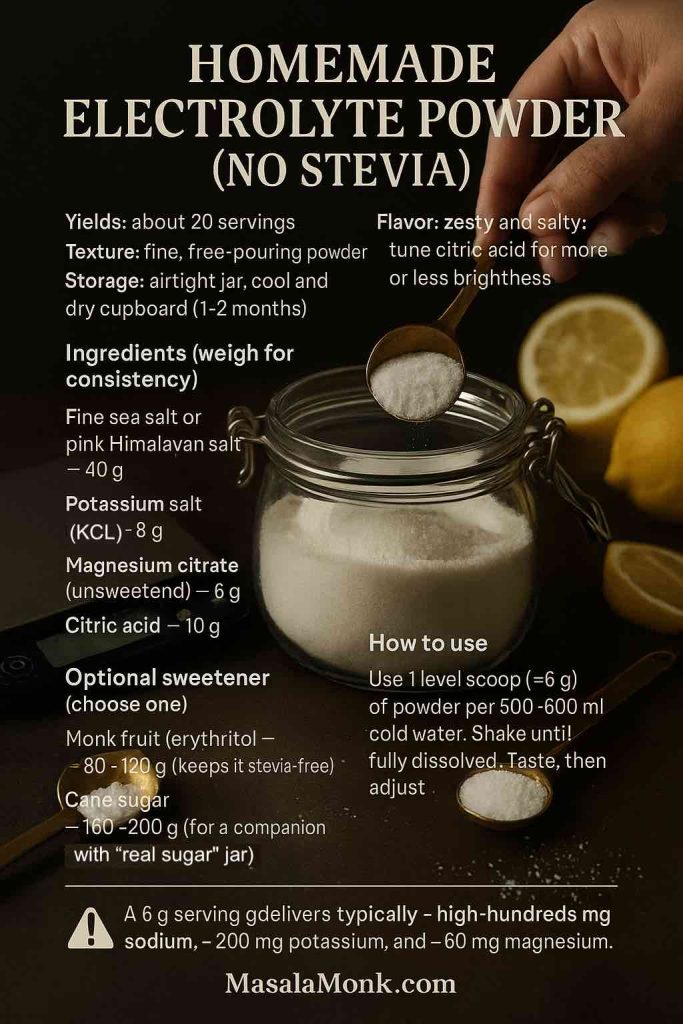
How to use
Add 1 level scoop (≈6 g) of powder to 500–600 ml cold water. Shake until fully dissolved. Taste, then adjust in your next bottle: a tiny bump of salt if you want more bite, a whisper more citric acid if you prefer extra zip, or a splash of fresh lemon if you want sharper edges.
Electrolyte ballpark
A 6 g serving made to the higher-salt preference will typically land you in the same neighborhood people often enjoy for training: high-hundreds of milligrams of sodium, with ~200 mg potassium and ~60 mg magnesium. This is not a promise of exact lab values—different salts vary—but it mirrors the feel of salty sticks like LMNT while letting you steer.
Salt choice—does it matter?
For flavor, choose what you like. For hydration value, sodium milligrams matter far more than trace minerals, which are tiny at realistic serving sizes. Pink Himalayan salt tastes great to some and looks pretty in the jar; sea salt dissolves quickly and is easy to weigh. Either way, weigh your salt, not just spoon it, and you’ll hit the same taste every time.
A note on potassium safety
Potassium chloride is effective yet potent. Measure carefully and stick to the intended serving size. If you’ve seen “cream of tartar hacks” online, skip them: cream of tartar is potassium bitartrate; in large amounts it can drive potassium far higher than intended. If you have kidney disease, heart issues, high blood pressure, or take medications that affect potassium, consult your clinician before experimenting.
Also Read: Electrolytes and Diarrhea: Best Drinks to Restore Balance Naturally
Liquid IV-Style Bottle (with real sugar and fresh citrus)
Sometimes a little glucose smooths absorption and makes a salty bottle more pleasant, especially in heat or during back-to-back sessions. When you want that classic lemon–lime vibe, this mix nails the Liquid IV-style profile while keeping ingredients minimal.
Per 500 ml bottle
- Water — 500 ml
- Sugar — 2 tbsp (≈25 g)
- Fine salt — ⅛ tsp (≈0.7–0.8 g)
- Potassium salt — ⅛ tsp (≈0.8 g)
- Fresh lemon or lime juice — 2 tbsp
- Optional: a pinch of vitamin C powder
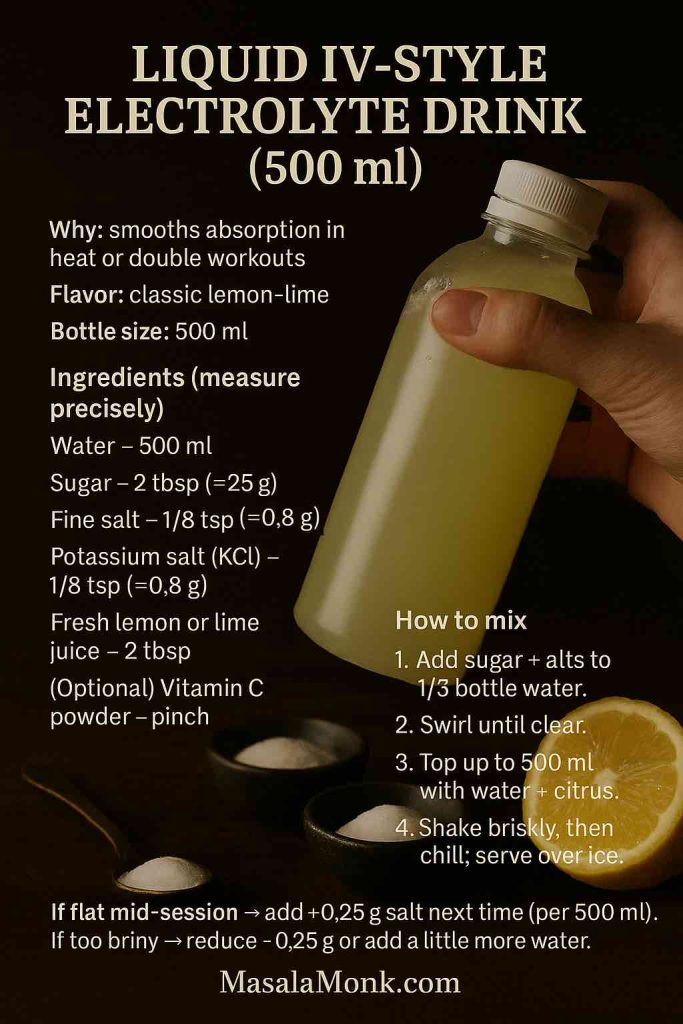
Shake briskly. If it tastes shy on salt mid-session, incrementally increase the salt next time by about 0.25 g per 500 ml until you find your preference. For context and calibration, skim the flavor and mixing guidance on the Liquid I.V. Hydration Multiplier page so you understand the intended profile you’re approximating—not because you must match it, but because it gives you a familiar anchor.
When your training is over and you’re craving something fresher and less “sports,” scroll through our Post-Workout Electrolyte Drink recipes for gentler blends that trade salt for fragrance.
Also Read: Benefits of Lemon and Lime Water: Refreshing Hydration with a Citrus Twist
LMNT-Style Zero-Sugar Bottle (salty, clean, stevia-free)
There are days when you want a bottle that’s unapologetically salty and entirely sugar-free. That’s where this LMNT-style mix shines. It echoes the public ratio from LMNT’s ingredient page—1,000 mg sodium, 200 mg potassium, 60 mg magnesium—scaled to your bottle and taste. Referencing their numbers gives you a practical target without hard-coding your personal salt ceiling.
Per 600 ml bottle
- Water — 600 ml
- Fine salt — ¼–⅜ tsp (≈1.5–2.3 g) → roughly ~600–900 mg sodium
- Potassium salt — ⅛ tsp (≈0.8 g) → roughly ~160–200 mg potassium
- Magnesium citrate — ⅛ tsp (≈0.6 g) → roughly ~60 mg magnesium
- Citric acid — ¼ tsp
- Optional: a dusting of monk fruit if you want a whisper of sweetness while staying stevia-free
If you’ve never tried a salty bottle, begin at the low end of the salt range and go up one small notch at a time. As your sessions lengthen and the weather warms, you might find yourself preferring the higher range. To see how the brand frames its own target, scan LMNT’s ingredients page and take note of its heavy-sweat positioning; not every day calls for a thousand-milligram bottle, and that’s the point of mixing your own—flexibility.
On strict fasting days, keep things zero-sweetener. For more ideas, browse fasting-friendly DIY electrolyte recipes that preserve flavor cues without calories.
Everyday variations that keep it interesting
Himalayan salt twist
Swap sea salt for pink Himalayan salt one-for-one if you enjoy its subtle mineral edge and rosy hue. Although the trace-mineral story sounds appealing, at the tiny amounts used in a bottle, the practical difference is negligible; think in sodium milligrams first, then season to taste.
No-sweetener, fragrance-forward
If you want aroma without sugar or calories, add lemon or cucumber slices rather than juice. The result tastes cleaner and doesn’t overpower the salt. On slow afternoons, a glass from our Cucumber Electrolyte Quenchers can be surprisingly satisfying.
Real-sugar days
Choose the Liquid IV-style bottle when the session is long, sweaty, or stacked with intervals. A bit of sugar can soften the salt and support pacing. Rotate lime, lemon, or even orange, keeping salt where it tastes right for that weather.
Citrus-free options
Some avoid citric acid for personal reasons or mouthfeel. If that’s you, simply leave it out and add a dash of apple cider vinegar for tang or a couple of drops of orange blossom water for aroma. The mineral profile stays the same; only the flavor arc changes.
Whole-food hydration
On non-training days, coconut water offers a mellow electrolyte background. For nuance on when it fits, take a look at our short explainer on the science of coconut water as a natural sports drink—useful if you prefer to alternate between salty bottles and gentler glasses through the week.
Also Read: Is Energy drink Gatorade Worth the Hype?
When you’re rehydrating from illness: use ORS, not a sports bottle
Electrolyte “sports” bottles and clinical oral rehydration solution (ORS) serve different jobs. If you’re recovering from diarrhea, food poisoning, or heat illness, reach for ORS because it leverages glucose–sodium co-transport in the gut to pull water back into your system efficiently. The home version is straightforward: 1 liter water + 6 level teaspoons sugar + ½ teaspoon salt, stirred until no crystals remain. Measure carefully—“heaping” spoons throw off the balance. For additional context and gentle drink ideas during recovery, see Electrolytes for diarrhea: best drinks to restore balance, which collects mellow, stomach-friendly options for the days after.
If you want a clinical overview while you recover, the Mayo Clinic has accessible hydration guidance, and the World Health Organization offers background on diarrheal illness and rehydration. In brief, ORS is a targeted tool for recovery; once appetite and energy return, slide back to your usual bottles.
How to dial in your Homemade Electrolyte Powder like a pro
Taste, then adjust deliberately
Begin with the written recipe. Sip mid-session and note whether you’re actually craving more salt or you’re simply warm and thirsty. If it tastes too briny even when you’re sweating, reduce salt next time by 0.25 g per 500–600 ml and retest. Conversely, if it tastes oddly bland and you’re craving chips after training, nudge salt upward the same small increment. Over a few sessions, you’ll land on numbers that feel unmistakably “right.”
Know your quick conversions
A handy mental shortcut: 1 gram of typical salt ≈ 390–400 mg sodium. With that, you can transform taste into numbers and track how your best-feeling bottles line up with what you poured. Once you’ve found your sodium sweet spot for a 500–600 ml bottle, keep potassium near ~200 mg and magnesium near ~60 mg, then use citric acid or fresh juice to position the brightness exactly where you like it.
Temperature and texture matter
Cold liquids mute both sourness and salt, which is why chilled bottles often taste “cleaner.” If a recipe tastes a bit sharp at room temperature, chill it before rewriting your ratios; perception changes with temperature. Likewise, dissolve powders in a third of your water first; once clear, top up. This simple sequence speeds mixing and prevents stubborn crystals from sticking to the bottle.
Storage and freshness
Pre-mixing can be convenient, especially for commutes to the track or trail. Nevertheless, homemade bottles taste best within a day or so, and refrigeration preserves the citrus edge. A pantry jar of powder lasts longer (1–2 months in an airtight container), but ready-to-drink mixes are more delicate—shake, chill, and finish soon.
Context is king
Short skills practice? Plain water often suffices. Hot, two-hour ride or long intervals? Bring out the salty bottle. Back-to-back training day with poor sleep? Consider the Liquid IV-style option for comfort. Overall, electrolyte bottles are tools: use them when conditions call for it rather than as a daily default.
Also Read: Coconut Water Cocktails: 10 Easy, Refreshing Drinks
A practical week of bottles (so it sticks)
Easy strength or mobility (≤45 minutes).
Water is fine. If you want a whisper of flavor, add lemon slices to water, not juice. Between sessions, pour a glass from our Cucumber Electrolyte Quenchers and call it good.
Long zone-2 run or ride (≥60–90 minutes).
Mix the LMNT-style zero-sugar bottle. If it tastes pleasant and you feel steady, you’re in a good zone; if you crave salt, notch it up slightly next time. For a second bottle, keep the same mineral balance but add a few drops of lemon for aroma.
Intervals or two-a-days.
Start with the Liquid IV-style bottle to ease the first set, then switch to a saltier, stevia-free bottle as the session wears on. When the weather is punishing, a two-bottle strategy can be a game changer.
Hot errand day.
Keep a mild bottle on hand: half your usual salt, a touch of citric acid, and a lemon slice. It’s more “refresh” than “sports,” and it keeps you from reaching for ultra-sweet sodas.
Post-illness return.
Use ORS while symptoms are active. The next day or two, transition to a simplified salty bottle—no sweetener at first—and then resume normal mixes. For inspiration, peek at our DIY natural electrolyte drinks for dehydration to rebuild gently.
Recovery treats.
When you’re feeling good again, rotate through our light Post-Workout Electrolyte Drink recipes. These are less about big sodium numbers and more about cooling down with flavor.
Also Read: What to Drink for Acid Reflux and Heartburn Relief: Soothing Solutions That Work
Troubleshooting taste & feel of Homemade Electrolyte Powder
“It’s too salty.”
Chill the bottle first—cold smooths edges. If it still tastes aggressive mid-session, reduce salt by 0.25 g the next time you mix 500–600 ml and reassess. If you’re consistently under your sweat threshold, you’ll find your “pleasant salty” zone in just a few rides or runs.
“It’s too sour.”
Cut citric acid by a pinch or switch from juice to slices for aroma without tang. Another option: add a tiny dash of baking soda to soften sourness, but do so carefully—too much flattens flavor and can mute the citrus.
“It’s bitter.”
Check your magnesium source. Magnesium citrate typically plays well in water at these amounts; some other forms can taste sharp. If bitterness persists, dissolve magnesium first in a small splash of warm water, then top up with cold.
“It’s bland.”
Add a touch more citric acid or squeeze fresh lemon. Sometimes blandness signals low salt; sprinkle an extra 0.25 g into your next 500 ml and see if “refreshing” suddenly becomes “ahh, that’s it.”
“I feel sloshy.”
Spread sipping out rather than gulping. If sloshiness recurs, consider less fluid per hour or a slightly higher sodium content to speed gastric emptying. Try smaller, more frequent sips and keep texture light and cold.
Also Read: Sip and Sparkle: Apple Juice Mocktails for Every Occasion
The recipes at a glance (so you can bookmark this section)
Homemade Electrolyte Powder (No Stevia)
- 40 g fine salt, 8 g potassium salt, 6 g magnesium citrate, 10 g citric acid
- Optional: 80–120 g monk fruit/erythritol or 160–200 g sugar
- Use 6 g per 500–600 ml water.
- For snackable variety, keep a second jar sweetened with sugar for long, hot sessions.
Liquid IV-Style Bottle
- 500 ml water, 2 tbsp sugar, ⅛ tsp salt, ⅛ tsp potassium salt, 2 tbsp lemon/lime juice
- Shake; chill for a smoother sip.
- For context: read the Liquid I.V. product page to understand the taste profile you’re approximating.
LMNT-Style Zero-Sugar Bottle
- 600 ml water, ¼–⅜ tsp salt, ⅛ tsp potassium salt, ⅛ tsp magnesium citrate, ¼ tsp citric acid
- Start at the low end of salt; climb gradually.
- Check LMNT’s ingredients page for the benchmark you’re echoing (≈1,000/200/60).
Illness/Recovery ORS
- 1 liter water + 6 level tsp sugar + ½ tsp salt; stir until fully dissolved
- Keep measurements exact; use ORS for recovery, not daily sipping
- For background: Mayo Clinic hydration guidance and WHO diarrhoea & rehydration overview
Closing thoughts—make the bottle yours
In the end, the best bottle is the one you’ll actually drink. By keeping a simple jar of homemade electrolyte powder at arm’s reach, you remove friction: scoop, shake, and step out the door. On days that call for sweetness, the Liquid IV-style bottle takes the sting out of salt and feels friendly; on the more Spartan days, the LMNT-style build keeps things crisp, focused, and clean. Meanwhile, when life tilts toward recovery or gentle movement, lighter options—coconut water, cucumber, or a whisper of citrus—carry you nicely without the athletic punch.
As your weeks roll on, jot a few notes in your phone: weather, distance or duration, salt grams (or teaspoons), whether you added sugar, and how it tasted at the 30-minute mark. After a handful of sessions, patterns emerge. You’ll see that hot, windy runs call for a different bottle than cool morning rides; you’ll notice that one squeeze of lemon feels perfect in spring but a full tablespoon tastes right in summer. And you’ll find that simple is powerful: weigh your salt, keep potassium and magnesium steady, let flavor guide you, and adjust in small, confident steps.
When you want to branch out or cross-reference ideas, dip into these for inspiration:
- DIY natural electrolyte drinks for dehydration — pantry-friendly blends for gentle days.
- Post-Workout Electrolyte Drink recipes — cool-down sips with easy ingredients.
- Electrolytes for diarrhea: best drinks to restore balance — ORS-style guidance for getting back on your feet.
- Science behind coconut water as a sports drink — when you’d rather keep it naturally mild.
With the essentials dialed and the jars labeled, your bottles start working for you—not the other way around. That’s the magic of making a homemade electrolyte powder that fits your routine, your climate, and your taste
FAQs about Homemade Electrolyte Powder
1) What is the simplest homemade electrolyte powder recipe?
Mix 40 g fine salt, 8 g potassium salt (KCl), 6 g magnesium citrate, and 10 g citric acid. Use 6 g of this homemade electrolyte powder per 500–600 ml water; adjust salt slightly to taste.
2) How do I make a Liquid IV–style drink at home?
Combine 500 ml water, 2 tbsp sugar, ⅛ tsp salt, ⅛ tsp potassium salt, and 2 tbsp lemon or lime juice. Shake well; chill for a smoother sip.
3) Can I copy the salty LMNT profile without stevia?
Yes. For a 600 ml bottle, start with ¼–⅜ tsp salt, ⅛ tsp potassium salt, ⅛ tsp magnesium citrate, and ¼ tsp citric acid. This mirrors the familiar ~1000 mg sodium / ~200 mg potassium / ~60 mg magnesium neighborhood.
4) What’s the best no-stevia option that still tastes good?
Go unsweetened and lean on cold water plus a touch more citric acid or lemon slices for aroma. Alternatively, use a monk fruit/erythritol blend in the jar to keep sweetness stevia-free.
5) How do I make electrolyte water with salt and sugar (ORS-style)?
Stir 1 liter water with 6 level tsp sugar and ½ tsp salt until fully dissolved. Reserve this for illness or heavy dehydration rather than daily sipping.
6) Is Himalayan salt better than sea salt for electrolytes?
Functionally, sodium milligrams matter far more than trace minerals at these tiny doses. Choose the salt you enjoy, weigh it for consistency, and keep your homemade electrolyte powder ratios steady.
7) What’s a fasting-safe electrolyte drink?
Use 600–750 ml water with ¼ tsp salt, ⅛ tsp potassium salt, and optional lemon slices (not juice) for aroma. Skip all sweeteners to keep it zero-calorie.
8) How can I make an electrolyte powder without citric acid?
Omit citric acid and add a pinch of lemon zest powder, or use a few drops of apple cider vinegar at mix time. Maintain the same mineral ratios; you’re only changing flavor.
9) How much sodium should I target per bottle?
For most hot or long sessions, aim roughly 600–1000 mg sodium per 500–600 ml. Start lower, then nudge up in 0.25 g salt steps until taste and feel line up.
10) What’s the safest way to add potassium at home?
Use potassium salt (KCl) and measure carefully—about 0.8 g per bottle typically yields ~160–200 mg potassium. Avoid large “cream of tartar” doses; stick to the intended serving.
11) Can I use real sugar sometimes and stay effective?
Absolutely. For longer or high-intensity efforts, 20–25 g sugar per 500 ml can improve palatability and feel; on easier days, go unsweetened or use monk fruit.
12) How do I prevent a drink from tasting too salty?
First, chill it. If it still feels briny, reduce salt by ~0.25 g per 500–600 ml next time and consider adding a touch more citric acid for balance.
13) How do I fix a bland bottle?
Increase citric acid slightly or add a squeeze of lemon. If blandness persists mid-workout, raise sodium in small increments until the flavor “pops.”
14) What magnesium form works best in water?
Magnesium citrate generally dissolves and tastes smoother at these small amounts. Start around 60 mg magnesium per bottle and adjust only if needed.
15) How can runners adapt the recipe for heavy sweat?
Begin with the LMNT-style ratios and test on a cooler day. Subsequently, raise sodium in modest steps for hotter runs, keeping potassium and magnesium steady.
16) What about cramps—do I need more potassium or sodium?
Often, sodium adequacy and overall hydration matter first; still, steady potassium (~160–200 mg) and magnesium (~60 mg) support balance. Tweak one variable at a time to see what changes the feel.
17) Can I make a travel-friendly dry mix?
Yes. Pre-portion 6 g servings of your homemade electrolyte powder into small sachets. Then, add one packet to 500–600 ml water on the go.
18) Is coconut water a natural electrolyte option?
Indeed. It’s gentler and lightly sweet by nature; however, it’s lower in sodium than most training mixes. If you use it during hot sessions, add a pinch of salt to bring sodium up.
19) How long will a jar of powder last?
Stored airtight in a cool, dry cupboard, most batches stay fresh 1–2 months. If you sweeten with real sugar, keep the jar bone-dry and reseal promptly.
20) What’s the quickest single-bottle recipe I can memorize?
For a 600 ml bottle: ¼–⅜ tsp salt, ⅛ tsp potassium salt, ⅛ tsp magnesium citrate, and ¼ tsp citric acid. Shake cold, taste, and adjust next time in tiny steps.
21) Can I scale the powder for a big training block?
Definitely. Multiply each dry ingredient by 2 or 3, then re-check taste with a single bottle. Consistency comes from weighing, not scooping.
22) Which bottle size should I choose?
Commonly, 500–600 ml feels right for most workouts; nonetheless, in extreme heat, larger bottles or more frequent refills help. Keep minerals proportional to volume.
23) How do I make a kid-friendly version?
Lower salt, add more water, and keep citrus gentle. Importantly, for illness, use the ORS ratio exactly and consult a clinician for age-specific guidance.
24) Does the order of mixing matter?
Yes. Dissolve powders in one-third of the water first; once clear, top up. Consequently, you’ll get faster dissolution and fewer gritty sips.
25) Can I store mixed drinks overnight?
You can, though flavor is brightest within 24–48 hours when refrigerated. Shake briefly before drinking, since minerals can settle.
